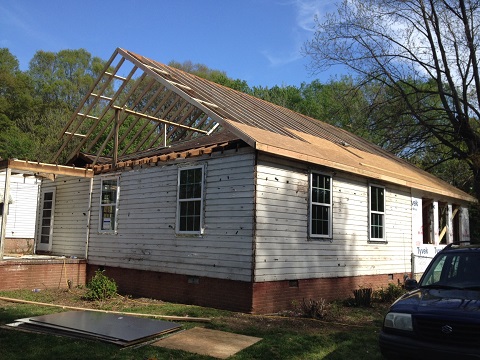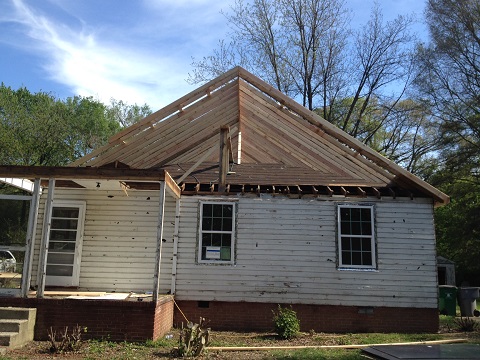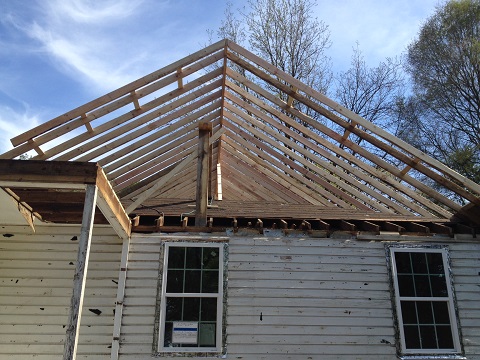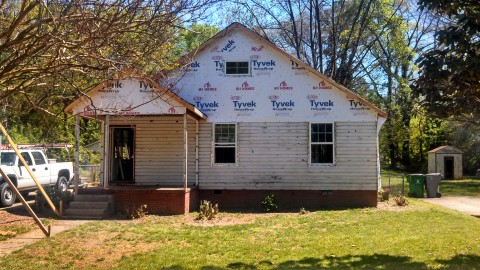Jamil Hudson and Brian Falls sent in this write-up and photos of something Charlotte Fire Department (NC) Engine 11 B shift recently came across during an area survey of their first due. Construction crews were in the process of remodeling both the interior and exterior of the home when E-11 noticed an obvious change of the roof structure. They stopped and spoke with a construction crew member to ask for permission to take some photos. As you can see in the photos, a second roof is being built on top of the existing roof. This construction practice is becoming increasingly popular today to modify older homes in order to reduce the costs for the homeowner or seller and to give the home a more modern and appealing look. The original roof was built on a 4/12 pitch and the newly added roof was built on an 8/12 pitch. There are several reasons why this type of roof construction can have a negative impact during normal fire ground operations. These are a few examples:
- A false indication of possibly a second floor or an additional room despite the small window (Size-up)
- Truck Co. operations (Vertical Ventilation) efforts may be hindered or delayed due to the double roof.
- Initial vertical ventilation could be ineffective for interior crews during fire attack and search operations if the fire has not vented through the original roof.
- Difficulty in locating and extinguishing hidden fire in void spaces. (Overhaul)
- Confusion between interior crews and the outside vent crew when attempting coordinated efforts (fire attack and vertical ventilation).
In addition, keep in mind the dimensions of lumber used, the type of roof construction and how it varies from the 1950’s to today. This particular home, the original roof joists were constructed of 2×6’s, while the new roof addition is light weight construction composed of 2×4’s. If fire has progressed rapidly, has vented itself through the original roof but has not shown itself from the new roof addition and has been burning for an extensive amount of time, what is the possibility of a collapse? If so, which of the two roof types may pose a danger of collapse, both, or maybe one before the other? What other issues could occur during a fire if this house is in your first due?
It is imperative as the individual fire fighter and as a company, we continue to be familiar with our response areas. Learning and knowing our territories and our buildings, from the single family dwellings, the large commercial/industrial buildings, to the high rises, etc. Building construction is ever changing, when the bell sounds at 3:00 am, the everyday house fire may just be the one fire that has us scratching our heads afterwards.





Good find fellas! Proud to have ridden the truck with you! It’s a shame that this type of renovation is even allowed.
Great article. We have MANY homes like this in the Houston area. And it’s exactly as you put it: its more common on older homes that are being remodeled. Its cheaper for the home owner to add that second roof on top, than to tear off the old one. As soon as someone pulls ceiling inside we can immediately tell if theres a newer roof on or not. There are also a few little ways to tell from looking from the outside.
Perry,
Thanks for the comment! What are some issues that you or your guys have incountered in Houston with these types of homes in addition to what is listed above? Always looking for some additional advice or info to keep in mind! Thanks brother!
Houston
The problem is multiplied when a apartment building from the early 80’s has a new pitched roof over a flat roof. We have made several apartment fires with “rain roofs” that went to multiple alarms due to the delay in identifying the rain roof and the extra work involved.
Several complexes have added pitched roofs to the buildings on the street side and perimeter of the complex for marketing reasons. This makes the apartment more attractive to renters with their “new look, under new management” marketing plan. The interior buildings still have the original flat roofs. Use google earth or a mapping program and you can easily identify these complexes.
To get to the new attic space you have to pull the ceiling and then cut through the underside of the old roof to get lines on the fire. Little giants and chainsaws and the 2-man pike pole works if the conditions allow and you are ahead of the fire.
Vertical ventilation will help control the movement in the new attic but heavy fire can still run the original attic space. A ladder pipe doesn’t solve the problem either. With the pipe flowing into the attic at one end all the smoke and heat finds its way back to the interior where the crews are working on the other end. The original roof does what it was supposed to do(keep the water out) so it doesn’t get to the original attic.
There is video on youtube where the civilians can be heard saying it has been burning for an hour. The rain roof, original roof and incomplete fire stops allowed heavy fire to burn off on an on for almost 2 hrs. On that fire we had to climb onto the orginal roof, inside of the new rain roof, and breach through fire walls to finally knock it all down.
A Kibler
Houston Fire Department
Sr Captain
Ladder 28
All I’ve got to say is……..that Jamil Hudson is one sexy BEAST !!
Thanks for the detailed info, all. Great stuff! One thought that I haven’t seen discussed on these types of roof additions: as well as adding difficulty in accessing the fire, venting, and creating a false sense of what’s going on, what about the added weight on the load-bearing walls of the structure, and how they will respond under fire conditions?
Even though it’s ‘light-weight’ construction, that’s a lot of dead load being added to the structural members, and it doesn’t look like there is any additional support being placed. So, how will the entire structure respond under fire conditions? If fire attacks the structural members of the building, are they going to support the added weight for as long as we’d expect, or will they fail early and cause a collapse? I’d love to see some live fire tests on acquired structures.
J.
Roof Over more information http://roofgenius.com
Thanks very roof calculator chech herehttps://roofgenius.com/roof-pitch-degrees.asp